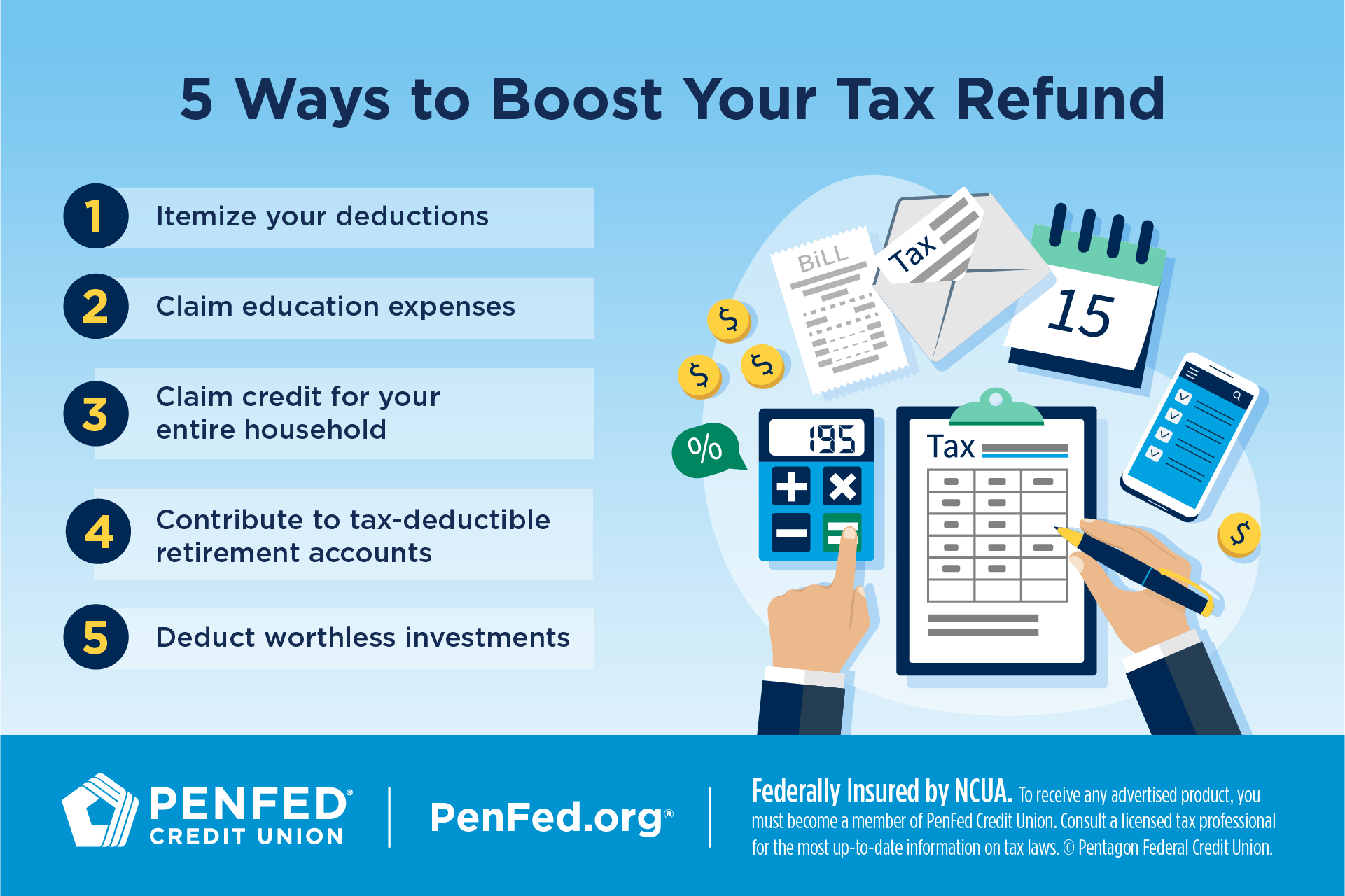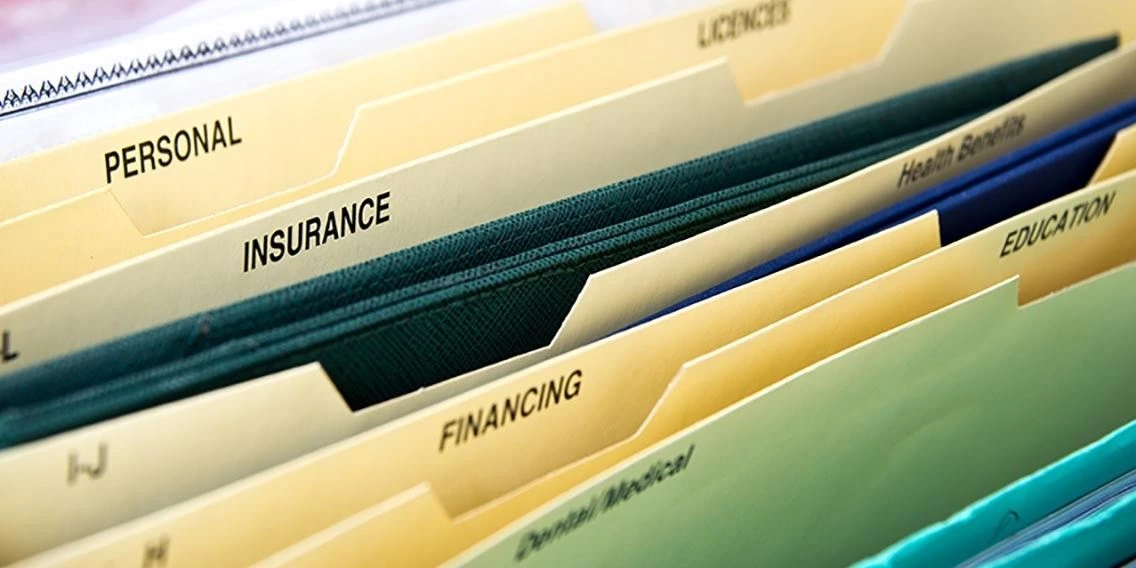FINANCE
Five Hidden Ways to Boost Your Tax Refund
What you'll learn: How to get more for your money with tax refunds
EXPECTED READ TIME:5 MINUTES
Whether you’ve got a lot of paperwork to track, or it looks like you’re going to owe money when you file, it’s safe to say most people don’t look forward to filing their income taxes. What everyone enjoys, though, (if you’re lucky enough) is getting money back. Whether you plan to use that money for a vacation or paying down debt, getting that refund is great.
Here are five steps you can take to get the most out of your tax refund this year and avoid missing valuable deductions.
Please remember to discuss your particular circumstances with an appropriate tax professional before taking action.

1. Itemize Your Deductions
The federal income tax standard deduction is $14,600 for singles ($29,200 for married filing jointly), so claiming it is tempting (rather than tracking down receipts and tax forms so you can itemize your deductions). But itemizing might be worth it if you’re a homeowner with a sizeable mortgage, gave money or other items to charity, or paid points when you took out your mortgage.
If you’re an educator, you can deduct up to $300 of school supply expenses even if you don’t itemize deductions. Start gathering information right away so you’ll have everything ready at tax time.
Itemizing might be worth it if you’re a homeowner with a sizeable mortgage, gave money or other items to charity, or paid points when you took out your mortgage.
Itemizing might be worth it if you’re a homeowner with a sizeable mortgage, gave money or other items to charity, or paid points when you took out your mortgage.
2. Claim Education Expenses
If you’re paying college expenses for yourself, your spouse, or a child, two education credits may help cover those costs: the American Opportunity Tax Credit (AOTC) and the Lifetime Learning Credit (LLC). The AOTC is a partly reimbursable credit for 100% of the first $2,000 of education expenses you pay and 25% of the next $2,000, for a maximum annual credit of $2,500. The LLC covers 20% of the first $10,000 of education expenses, and thus it maxes out at $2,000 for eligible filers.
The AOTC and LLC are both eliminated once a single filer’s modified adjusted gross income (MAGI) exceeds $90,000, and both start phasing out at $80,000. You can only claim one per student — although you might be able to claim both if you have two students on the same claim. Weigh your options carefully when deciding which credit to claim.
Tip: Start early in gathering the data you’ll need to claim the deduction and consider prepaying tuition or other costs to get the maximum credit possible.
Start early in gathering the data you’ll need to claim the deduction and consider prepaying tuition to get the maximum credit possible.
Start early in gathering the data you’ll need to claim the deduction and consider prepaying tuition to get the maximum credit possible.
3. Claim Credit for Your Entire Household
In some cases, tax credits may be more valuable than deductions. For example, if your adult children, their significant others, and/or friends came to live with you, you may be eligible to claim a $500 tax credit for non-child dependents you support. You can also claim the Dependent Care Credit for parents you support, even if they don’t live with you.
Tip: Stick a note into your tax file (of course, you’re on it with a ready-to-go tax file) reminding you to look into claiming these credits at tax time. And make sure you understand the rules for claiming dependents when it comes time to file.
4. Contribute to Tax-Deductible Retirement Accounts
This is a way to save for your future and boost your tax refund. If your income is under $73,000 $76,500, you may qualify for all or part of a Saver’s Tax Credit as well, up to 50% of the amount of your retirement contribution. You have until the tax filing deadline to contribute to an IRA for the given tax year, but if you’re eligible for the Saver’s Tax Credit, make sure to contribute to your 401(k) and IRA by the end of the tax year to claim the credit.
Make sure to contribute to your 401(k) and IRA by the end of the year to claim your Saver’s Tax Credit.
5. Deduct Worthless Investments
Keep in mind, if you have an investment that went belly-up and you sell it before the end of the year, you can try to claim a tax loss. If someone owes you money that you can’t collect, you may be able to claim that as a “bad debt” deduction as well.
Write a description of the debt that includes the name of the debtor, the amount, the date the debt was due, and any relationship between you and the debtor. Describe the efforts you made to collect and why you think the debt is now worthless.
The Takeaway
Taxes are stressful, but refunds are grand — even better when you’re empowered by the knowledge that you may be eligible to boost the amount money you’ll get back. And of course, don’t forget that you won’t get a tax refund until you file your tax return, so make sure you complete everything on time! Even if you aren’t required to file a tax return because your income is low, file anyway to claim your refund for taxes withheld and any refundable credits to which you’re entitled. (If you wait more than two years to file, the IRS will not issue you a refund.)
Getting Your Biggest Tax Refund Has Never Been Easier
PenFed members can take advantage of exclusive discounts for H&R Block or Turbo Tax.




